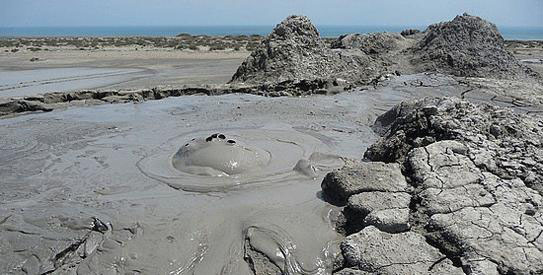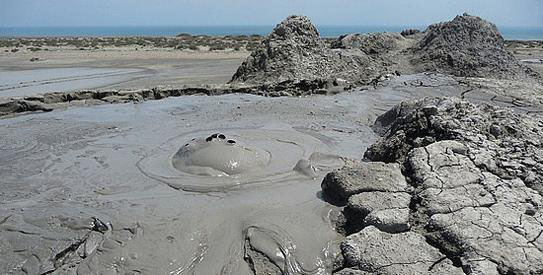Mud volcanoes that arose from ocean emitting methane in Pakistan

Last yearone-square-kilometre island that emerged off the Makran coast, near the point where the Hingol River drains into the sea, in Pakistan. Scientists collected samples. Studying the water and sediment samples scientists found well-preserved shells of certain marine organisms that are known to survive on sulphur and methane.
The island located at a distance of two kilometres from the Makran coast is reported to have been collapsed due to strong currents and winds in a similar way as happened in the case of the island that emerged in the same area in 1999. The recent appearance of the island was looked at as the re-emergence of the past island — Malan. Malan Island is actually an offshore mud volcano located in the Arabian Sea, 3 kilometres off the coast of Balochistan, Pakistan.
The finding, according to the scientists, provides scientific evidence to the widely held belief that the specific area has marine reserves of methane gas.
This is the first time that scientists have found rocks and boulders with burrows and holes that indicates the forceful eruption of the mass. Also, the presence of huge rocks on the island led them to assume that this time the island had emerged with greater pressure. But they are not sure about the exact depth from where the mass has erupted.
Other findings of the samples’ testing showed dominant presence of clay minerals such as muscovite and chlorite with quartz and calcite. The elemental composition of the sediments was dominated by silicates, aluminium, calcium and iron.The shells are probably of the calyptogena species, which is known to survive on sulphur and methane. A strong correlation was found between the sediments of the offshore island and the onshore mud volcanoes. The analysis of the gas sample taken from the water column of the offshore Malan Island showed that it contained methane, ethane, propane and butane. All data pointed to the presence of microbiologically generated bacterial methane, excluding thermogenic gas.
Scientists claim, the Makran coastal belt is reported to have extensive reserves of frozen methane that exist in the form of gas hydrates (crystalline water-based solids physically resembling ice which were formed under conditions of relatively high pressures and low temperatures) hundreds of metres below the sea floor. And whenever this highly pressured gas finds a weak space to release some of its energy, a dome-like structure (island) is created within the waters or it emerges on the sea surface.
The space to release energy could be formed due to tectonic movements, creating some fractures and fissures in the strata. Sometimes, the structures do not come out of the water and so go unnoticed. (Dawn)



Pakistan is colapsing very very slow but steady, then this methan emitions are a cause, on my vew, of the movements on the soil of the indian against eurasian plate. The eurasian is on friction with the arab plate and the result is to crack the border, where is Pakistan. It means a change very serious for the Pakistan territory and at the end the beginning of the great changes in the area. Of course India is the next.
SALUDOS!!!